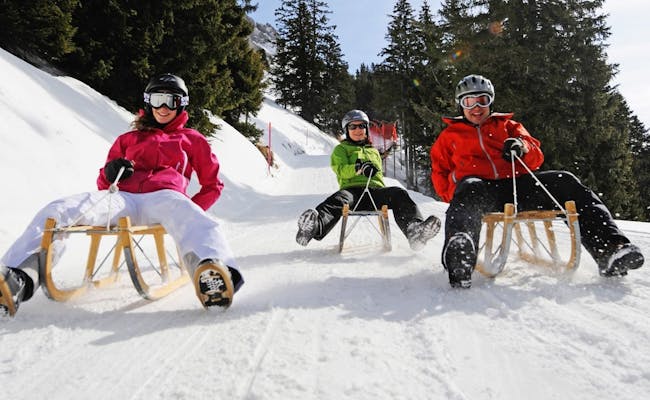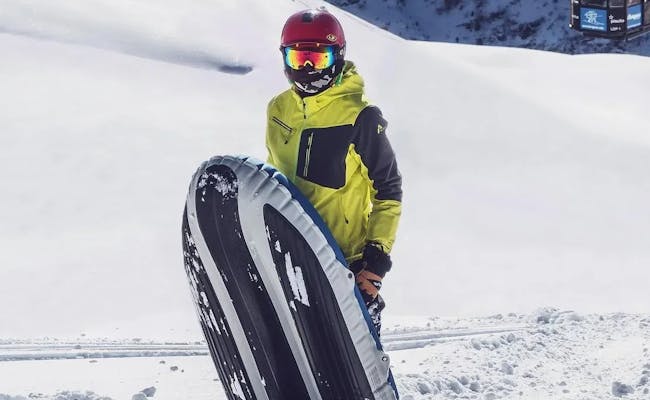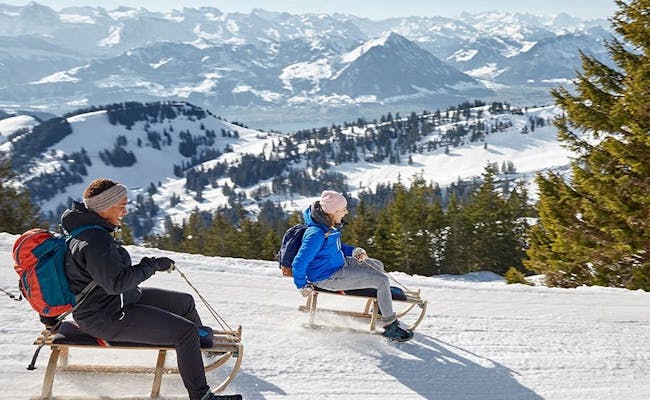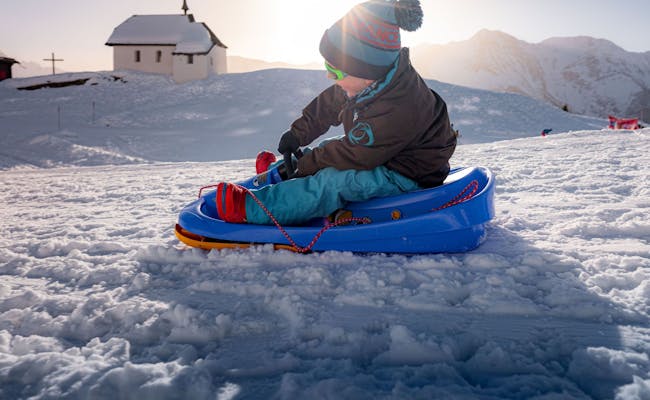
Ticket
Sledding Rigi day ticket incl. train ticket
Validity: All day
booked 67 times

6 Activities

Ticket
Sledding Rigi day ticket incl. train ticket
Validity: All day
booked 67 times

Ticket
"Eiger Run" from the Eiger Glacier Sledging ticket Eiger Express from Grindelwald
Validity: All day
booked 199 times

Ticket
First Bachalpsee sledging ticket from Grindelwald
Validity: All day
booked 59 times

Ticket
"Eiger Run" from Kleine Scheidegg Sledging ticket incl. train ticket from Grindelwald
Validity: All day
booked 13 times

Ticket
"Fox Run" Kleine Scheidegg toboggan ticket incl. train ticket from Wengen
Validity: All day
booked 12 times

Ticket
Sledging ticket Pizol from Wangs
Validity: All day

Ticket
Sledding Rigi day ticket incl. train ticket
Validity: All day
booked 67 times

Ticket
"Eiger Run" from the Eiger Glacier Sledging ticket Eiger Express from Grindelwald
Validity: All day
booked 199 times

Ticket
First Bachalpsee sledging ticket from Grindelwald
Validity: All day
booked 59 times

Ticket
"Eiger Run" from Kleine Scheidegg Sledging ticket incl. train ticket from Grindelwald
Validity: All day
booked 13 times

Ticket
"Fox Run" Kleine Scheidegg toboggan ticket incl. train ticket from Wengen
Validity: All day
booked 12 times

Ticket
Sledging ticket Pizol from Wangs
Validity: All day
Sleds have been around for thousands of years. In the past, they were used mainly for transportation. With the beginning of the 19th century, the sled is also used as a sports equipment
There are two types of sledges that are used in the majority in Switzerland. On the one hand, there is the legendary, good-natured and popular Davos sledge made of wood. On the other hand, we have the nippy toboggan, which with its sharp runners provides a good grip in the curves and a rapid descent
 (Foto: Elsigen Metsch)
(Foto: Elsigen Metsch) (Foto: Saastal Tourismus AG)
(Foto: Saastal Tourismus AG)The sled is a traditional device for trips on snowy slopes and groomed slopes. Be it the simple wooden sled, the sleek sports equipment or the practical sled for the children Sleds and toboggans come in different models and lengths - for sitting or lying down. For the recreational toboggan of an adult, a length of 115 cm applies. Anyone who sleds with children knows: they quickly get tired or freeze. In this case, a suitable sled seat and a sleeping bag with warm lining are also recommended
The Davos sled, made of ash wood with iron-covered runners, fixed wooden construction and traction iron, was developed on the occasion of a sled race in 1883. This model is the origin of all recent sleds up to the racing bob. Anyone traveling with small children will appreciate the Davos sled
The Davoser is usually between 80 and 130 cm long and, unlike the toboggan, is steered and braked with the feet. Due to the fact that the Davos sled is slower than the toboggan, it is particularly suitable for leisurely descents with children. Due to the fact that there are also longer models, more than one person can easily ride on a sled.
 Schlitteln in Engelberg (Foto: Engelberg TItlis Tourismus AG)
Schlitteln in Engelberg (Foto: Engelberg TItlis Tourismus AG) Schlitteln auf der Rigi (Foto: Rigi Bahnen)
Schlitteln auf der Rigi (Foto: Rigi Bahnen)Unlike "normal" sleds, the runners on toboggan models are angled up to 25 degrees and are not rigidly connected. The runners, made of a special steel, make your device fast and agile. For maintenance, there are paste and liquid waxes that are applied after use. These also serve as rust protection. Special edge sharpening sets are available for sharpening blunt edges.
To ride, you sit on the tarp, lie backward, tense your abdominal muscles, and have your feet on the ground exclusively for braking. You steer by pressing your feet on the skids, supported by pulling on the leash. Braking is done by shifting your weight backwards and pressing the whole sole of your shoe to the floor. If you want to brake even more, slide back a little and lift the device slightly at the front of the skid.
In Switzerland, two brands of sleek toboggans are best known: the Lindauer and the Torggler. The Lindauer toboggan was created in collaboration with racers and became what it is today with Jo Lindauer's years of experience
Torggler's product line ranges from recreational toboggans to professional racing sleds. Due to its sophisticated design and high quality, Torggler sleds are among the best known sled builders in the Alps. World class tobogganists trust in Torggler toboggans
 Rodelschlitten fahren (Foto: Schweiz Tourismus Lorenz Richard)
Rodelschlitten fahren (Foto: Schweiz Tourismus Lorenz Richard) Schlitteln in Bergün (Foto: Schweiz Tourismus Christof Sonderegger)
Schlitteln in Bergün (Foto: Schweiz Tourismus Christof Sonderegger)Inflatable sleds are suitable for gently sloping and less steep toboggan runs. Similar to the handy snow slides, called "Füdlibob" in Switzerland, they are the ideal vehicle on freshly snow-covered hills. Last but not least, they score points for their size and light weight.
Meanwhile, the airboard convinces as an inflatable high-speed sled. It is often referred to as a snow bodyboard. Unlike the skibob or the wooden sled, it fits into any backpack without air.
Other criteria for the airboard are good handling and high speeds. In addition, it is suitable both on groomed slopes and in deep snow
 Airboard (Foto: Destination Davos Klosters)
Airboard (Foto: Destination Davos Klosters) Airboard (Foto: Destination Davos Klosters)
Airboard (Foto: Destination Davos Klosters)Skibob is the right choice for you if you want to try something else instead of skiing. The two-track skibob is recommended. Here you steer with a third ski, which is connected to the handlebars
In the end, whether with the Davos sled, the toboggan or on an airboard: sledding is fun. With a simple basic equipment you are there and you can start.
The Velogemel can be found in the Bernese Oberland. Modeled after a bicycle, it can be used like a sports sled. It has a frame with a saddle, runners and a handlebar that is not fixed. Fast rides become possible on the Velogemel in a comfortable position both on slopes and on snow-covered roads. In Grindelwald, a world championship with the Velogemel takes place every year at the beginning of February.
 Velogemel Meisterschaft (Foto: Jungfrau Region Grindelwald)
Velogemel Meisterschaft (Foto: Jungfrau Region Grindelwald) Velogemel Meisterschaft (Foto: Jungfrau Region Grindelwald)
Velogemel Meisterschaft (Foto: Jungfrau Region Grindelwald)The Bergfink is a sports sled ergonomically designed for young adults. It has room for a child in front of the adult, is wider and comfortable to ride. Instead of steel runners, the Bergfink has two highly wear-resistant PE-1000 plastic runners that glide better. For both fresh snow and on ice, the Bergfink grips well. It is produced sustainably, yet it has one drawback. The abrasion of the skids is very strong, making it not environmentally friendly. The skids can be driven on both sides and can be quickly replaced.
Skibock, Skigibel and Balancer are a mixture of ski and sled. They were virtually created from a seat with skis and differ little from each other. With the balancer, skibock or skigibel, you're dynamically carving down the slope.
You steer it by shifting your weight and you can even fold it for transport. These types of sleds are ideal for extended rides on wide slopes. Championships are regularly held on the Tschentenalp with the Skibock.
In some parts of Switzerland, similar toboggans are called SNOOC. SNOOC were first produced in the French Alps in France. They have the advantage that you can alternate between skiing and - quickly converted - sledging. Meanwhile, you can rent the SNOOC in places like Adelboden, Wengen or Zermatt.
 Skibock bevorzugt aus Holz (Foto Tschentenalp)
Skibock bevorzugt aus Holz (Foto Tschentenalp) Snooc Holz, Metall und Kunststoff (Foto Tschentenalp)
Snooc Holz, Metall und Kunststoff (Foto Tschentenalp)Wood is still the preferred material for most types of sledges.
| Sled type | Features | Material | Suitable for |
|---|---|---|---|
| Davos sled | good-natured, classic in Switzerland | wood | children, families, beginners, cozy |
| Toboggan | good in tight turns | Wood | fast descents, advanced |
| Airboard | light weight, fast, difficult to steer and brake | durable, soft material | depending on slope inclination for beginners or advanced, hard slopes or deep snow |
| skibob | only on ski slope | plastic/steel | older children and adults |
| Velogemel | on slopes and snow-covered roads | Wood: ash wood for frame and runners, maple wood for handlebars and saddle | Older children and adults |
| Skibock, Skigibel, Balancer | on slopes and snow-covered roads | wood, possibly metal | Older children and adults |
| Bergfink | light and ergonomically shaped | wood, metal, plastic | young adults |
| SNOOC | on slopes and snow-covered roads | wood, metal, plastic | older children and adults |
Many ways lead to the starting point of your sledding route. Be it by train, by post bus, on foot or with a team of huskies. In Switzerland there are numerous offers how you can start your sledding adventure
With the cable car
Countless ski resorts prepare high quality sledding slopes and offer a sledding ticket. With it, you load your sled onto the chairlift or cable car and ride with the skiers from the bottom station to the top station. Unlike the skiers, who then head for the slopes, you head for the toboggan run and enjoy one descent after another without ever having to pull the toboggan up the mountain.
By train
At selected locations, you have the option of loading your sled onto the train to travel to the starting point. Two very popular and well-known areas are the Rigi, where a total of five toboggan runs are waiting for you, and the Preda toboggan run in Bergün
By bus or post bus
The iconic yellow Postbuses, which you will encounter almost everywhere in Switzerland, are also a popular means of transport for sledging fun. Whether you're in the Bernese Oberland, Eastern Switzerland or Valais, in many places in Switzerland you have the option of loading your sled into the Postbus and taking it to the starting point of the sledding run
A true sledding paradise is in Grindelwald. From Grindelwald, a bus will take you to Bussalp, from where you have numerous options to choose from. One of them is a 2.5-hour hike up the Faulhorn, where the world's longest sled run (15 km) back to Grindelwald awaits you
On foot
Sledding is an activity that doesn't have to involve a long ride and a ticket. Of course, you have the option of taking a walk in winter and combining it with a sled ride. Especially deserted forest paths are suitable for this, where there are no dangerous situations with cars
All over Switzerland there are prepared toboggan runs that can only be reached on foot. You probably won't make quite as many runs as you would in a ski resort, but sledding feels all the better for it because you've earned every meter of travel after pulling yourself up.
 Schlitteln zu Fuss (Foto: Schweiz Tourismus Martin Maegli)
Schlitteln zu Fuss (Foto: Schweiz Tourismus Martin Maegli) (Foto: Jungfraubahnen AG)
(Foto: Jungfraubahnen AG)With the dog
For some, probably the most beautiful way to sled is with a dog sled. With a husky team you whiz through the white splendor in no time. Gently, the sled runners make their way behind the huskies. With professional help and well-trained dogs, you can experience a different kind of excursion on a guided sled tour.
 (Foto: Tschentenbahnen)
(Foto: Tschentenbahnen) Snowtubing (Foto: Titlis Bergbahnen)
Snowtubing (Foto: Titlis Bergbahnen)You don't need much to go sledding. A snowy slope is already enough. However, the range of groomed slopes is immense and if you are looking for inspiration for your next sledding trip, we have a selection of destinations all over Switzerland for you
Europe's longest illuminated toboggan run runs beneath the towering viaducts through an enchanting winter landscape. You can rent your toboggan at the train station in Bergün or bring it yourself. With the tobogganing ticket you can go up to the starting point by train as often as you like and go down again on the winding pass road, which is closed to traffic
 Schlitteln Bergün (Foto: Schweiz Tourismus André Meier)
Schlitteln Bergün (Foto: Schweiz Tourismus André Meier) Nachtschlitteln Bergün (Foto: Schweiz Tourismus André Meier)
Nachtschlitteln Bergün (Foto: Schweiz Tourismus André Meier)The toboggan run in Lenzerheide leads from the middle station Scharmoin in numerous curves down the mountain to the valley station of the Rothorn cable car. A ride on the toboggan takes about 15 min before you get back on the gondola and float down to the middle station for another run. Due to the fact that the slope is very well prepared and safe, it is ideal for families.
 Schlitteln in Scharmoin Lenzerheide (Foto: Ferienregion Lenzerheide)
Schlitteln in Scharmoin Lenzerheide (Foto: Ferienregion Lenzerheide) Light Rider Lenzerheide (Foto: Ferienregion Lenzerheide Cemil Erkoc)
Light Rider Lenzerheide (Foto: Ferienregion Lenzerheide Cemil Erkoc)The longest toboggan run in eastern Switzerland leads from the summit of the Kronberg down to Jakobsbad. You reach the Kronberg by cable car from Jakobsbad, before the daily groomed run with first flatter, then steeper sections awaits you. The Scheidegg inn on the way is perfect if you need refreshments or want to warm up in between.
The toboggan run on Zug's local mountain is easily reached by funicular railroad from the Schönegg valley station. At the top station on the Zugerberg, apart from a wonderful view, a prepared toboggan run is waiting for you. In addition, the restaurant Zugerberg offers a good opportunity for refreshment with a delicious punch or a hot tea.
The Rigi beckons with its panoramic sledding slopes and winter hiking trails. On the queen of the mountains you will find various well-prepared slopes. The slopes are accessible with the Rigi cable cars and you have the opportunity to arrive from Vitznau, Goldau, Weggis or Kräbel.
 Schlitteln auf der Rigi (Foto: Rigi Bahnen)
Schlitteln auf der Rigi (Foto: Rigi Bahnen) Schlitteln auf der Rigi (Foto: Rigi Bahnen)
Schlitteln auf der Rigi (Foto: Rigi Bahnen)At the foot of the Titlis, the toboggan run leads from Gerschni to Engelberg. In addition to a stunning view of the Titlis, a downhill run with flat, steep and winding sections awaits you. Transport from Engelberg to the starting point is by funicular up to Gerschnialp
The toboggan run in Elsigen Metsch near Adelboden takes you through forests and over open terrain. You will not have to dismount and walk once. The cable car will bring you back up to Elsigenalp for the next descent.
On Adelboden's local mountain wonderful toboggan runs of various levels of difficulty await you. The Tschentenbahn takes you in a circulating cable car, where three cabins travel together, from Adelboden to the starting point of the toboggan run. During the high season between the end of December and mid-March, night sledding takes place on Wednesdays and Saturdays, where you can jet off into the night under the stars.
 Schlitteln Tschentenalp (Foto: Tschentenbahnen)
Schlitteln Tschentenalp (Foto: Tschentenbahnen) Schlitteln Tschentenalp (Foto: Tschentenbahnen)
Schlitteln Tschentenalp (Foto: Tschentenbahnen)While the Mediterranean Ticino beckons in summer with its southern lakeside promenades and gelati under palm trees, in winter it is sledding fun. The toboggan run from Pian Nara leads through coniferous forests, over snow-covered slopes and through village centers worth seeing. The chairlift takes you from Leontica first to Cancori and then to Pian Nara, where the descent can begin.
 Schlitteln in Nara (Foto: Ticino Tourismus)
Schlitteln in Nara (Foto: Ticino Tourismus) Schlitteln in Nara (Foto: Ticino Tourismus)
Schlitteln in Nara (Foto: Ticino Tourismus)The valley station of the "Diablerets Express" is not far from the village center. From here, the cable car will take you to the ski resort of Le Meilleret, where the ride starts on the closed road to the Col de la Croix. On the first part of the descent you get a breathtaking view of the Diablerets mountain massif, before it zigzags through the forest back towards the valley
Sledding can be done at any time of the day or night. There are slopes specially designed for night sledding. Thereby the mountain railroads are operated also in the evening and the slopes are illuminated with floodlights.
But you can also try night sledding on your own with a strong headlamp and the right equipment. We have put together an ultimate guide where we present you 60 routes for night sledding in Switzerland.
 Nachtschlitteln (Foto: Ferienregion Lenzerheide Bernd Kammerer)
Nachtschlitteln (Foto: Ferienregion Lenzerheide Bernd Kammerer) Nachtschlitteln Bergün (Foto: Schweiz Tourismus André Meier)
Nachtschlitteln Bergün (Foto: Schweiz Tourismus André Meier)In Switzerland, around 7,000 accidents occur each year while sledding. More than half of these are caused by children and young people under the age of 16. So it's important to follow a few rules so that sledding fun doesn't end up in the emergency room.
 Schlitteln Riederalp (Foto: Aletsch Arena)
Schlitteln Riederalp (Foto: Aletsch Arena) Schlitteln Riederalp (Foto: Aletsch Arena)
Schlitteln Riederalp (Foto: Aletsch Arena)With due caution, sledding is a safe experience for children that most will want to try as soon as the first snowflakes fall.
However, there are a few rules to follow to avoid any nasty surprises. Children under the age of eight in particular have trouble assessing dangers in time and therefore often react too late.
It is therefore important that parents supervise their children and make sure that no potential dangers lie in wait. Ideally, you should not sled with your children near obstacles such as fences, pedestrians, skiers, cars or walls. Flat sloping hills in open meadows or deserted forest trails are best.
In addition, children should not sled until they can steer and brake independently. Just sitting stably is not enough. A helmet is also essential, as falls can often result in blows to the head.
There are numerous sledding trails in Switzerland that are especially suitable for children. Below you will find four popular runs for the whole family.
Nara Ticino
Here you sled under palm trees and with a fantastic view. From the mountain station in Cancorí a 10 km long slope leads back to the village of Leontica Suitable for children from 0 years Next stop: Leontica, Chiesa No parking available Prices day ticket chairlift: adults 35 CHF / children 30 CHF
Black Lake Fribourg
The 300 m long toboggan run in the foothills of the Fribourg Alps is the perfect adventure area for little snow bunnies. About 50 meters of altitude have to be covered and the toboggan has to be pulled up again afterwards. Suitable for children from 0 years Next stop: Schwarzsee Hotellerie or Gypsera Parking spaces available Prices: Sled run free of charge / Sled rental 5 CHF per hour
Elm Glarus
A 4 km long toboggan run promises wonderful tobogganing fun for the whole family after a gondola ride. The sledding fun lasts about 20 min and is especially fun in the middle, somewhat steeper part. Suitable for children from 0 years Next stop: valley station Sportbahnen Elm No parking spaces available Prices day ticket cable car: adults 36 CHF / children 20 CHF
Lake Oeschinen Bernese Oberland
From the top station, an approx. 4 km long slope leads through a magnificent landscape past the wintry Oeschinensee Suitable for children from 7 years Nearest train stop: Kandersteg Paid parking available at valley station Prices cable car day ticket: adults 44 CHF / children 31 CHF
 Schlitteln mit Kindern (Foto: Aletsch Arena)
Schlitteln mit Kindern (Foto: Aletsch Arena) Schlitteln mit Kindern (Foto: Aletsch Arena)
Schlitteln mit Kindern (Foto: Aletsch Arena)It goes without saying that you should not put your baby on the sled alone. Special seats help your baby stay on the sled while you pull it up the hill. To ensure that nothing happens to your offspring, sled rental companies usually have child seats for babies and toddlers on offer. In addition, sleds can be made suitable for children in no time. For almost all models there are inexpensive backrests to attach. The foot bag from the stroller fulfills the same function on the sled and keeps your baby nice and warm.
With the right equipment, sledding is twice as much fun. If you don't have your own sled or would like to try out a different model, you can rent a sled for your sledding adventure. Often mountain railroads that prepare their toboggan runs offer various models for rent.
The following items are part of the equipment for sledding:
 (Foto: Zermatt Tourismus Pascal Gertschen)
(Foto: Zermatt Tourismus Pascal Gertschen) (Foto: Jungfrau Region)
(Foto: Jungfrau Region)In conclusion, we may state: Switzerland is a true sledding paradise. Everyone will find what they are looking for here: Families with small children, young amateurs and experienced sledding professionals. The landscape also leaves nothing to be desired
In a fabulous setting, sledding fans conquer the slopes of Switzerland with their toboggans. They master the curves, shifting their weight to steer, the soles of their shoes crunching and braking in the ice.